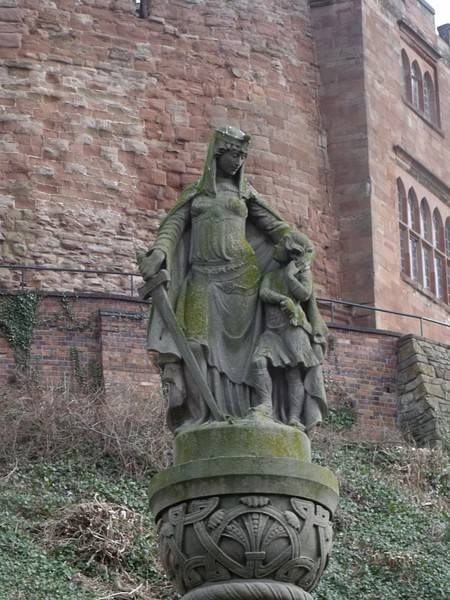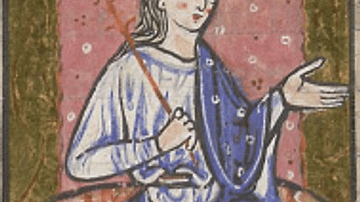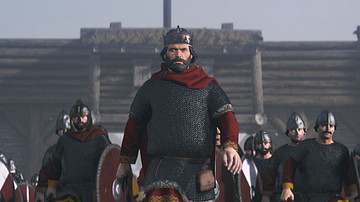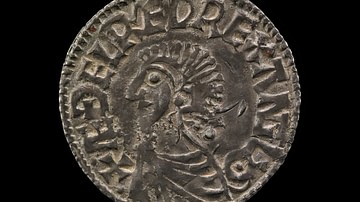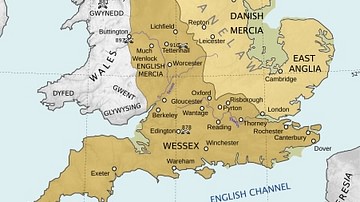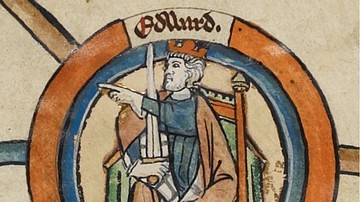
Aethelred ruled as Lord of the Mercians from c. 881 to 911 and was a key military leader in the fight against Viking conquest and settlement in England. To defend Mercia, he allied himself to the powerful Kingdom of Wessex under the leadership of Alfred the Great (r. 871-899) and later married Alfred's daughter, Aethelflaed, to strengthen their alliance.
Today, Aethelred is primarily remembered as King Alfred's dutiful son-in-law or as the husband of the celebrated Aethelflaed, Lady of the Mercians. However, he was an important historical figure in his own right, who led Mercia during a time of intense conflict and transformation, which lay the foundations for the unification of England that would be completed in 927 by Aethelred's foster son, King Aethelstan (r. 924-939).
Historical Sources & Modern Depiction
Aethelred's life is documented in several contemporary sources. The Anglo-Saxon Chronicle, a chronicle recorded at Alfred's court in the 890s, and Bishop Asser's Life of King Alfred, a contemporary biography of Alfred, provide key but limited details on Aethelred's life, including his relationship with Alfred and his military campaigns. Additionally, several of Aethelred's land charters still exist, providing valuable records of his land and property transactions and his interactions with the Mercian clergy and nobility. We are also aided by the Fragmentary Annals of Ireland, a series of later medieval Irish chronicles. These annals provide insight into the later years of Aethelred's life, which were marked by illness and Mercia's defence against Norse-Irish Viking raids in Britain.
Interest in Aethelred has grown in recent years, primarily due to Toby Regbo's portrayal of him in the TV show The Last Kingdom (2015-2022), in which he is depicted as an incompetent and cowardly ruler who resents his wife. However, Bernard Cornwell – the author of The Saxon Stories, on which the show is based – admitted his portrayal of the Mercian leader was unfair to the real historical Aethelred. From the limited source material on Aethelred and his character, we see a courageous soldier and capable ruler who enjoyed a healthy relationship with Aethelflaed and was remembered by medieval chroniclers as a "man of distinguished excellence" and a "valorous earl" (Forester, 89 & Giles, 239).
Mercian Background & Aethelred's Rise to Power
In the mid-9th century, Anglo-Saxon England comprised four kingdoms: East Anglia, Mercia, Northumbria, and Wessex. The Midland kingdom of Mercia had previously wielded considerable influence over much of southern Britain during the reigns of Aethelbald (r. 716-757) and Offa (r. 757-796). However, in 825, King Egbert of Wessex (r. 802-839) defeated the Mercians at the Battle of Ellandun, effectively ending what is often called the 'Mercian Supremacy.' By the 850s, during the reign of King Burgred of Mercia (r. 852-874), the two kingdoms began to form closer relations and worked together to oppose the increasing Viking threat. Despite these efforts, Burgred failed to deter the Great Heathen (Viking) Army, which conquered Northumbria and East Anglia in the late 860s and drove him into exile in 874. His successor, Ceolwulf II (r. 874-879), was forced to surrender eastern Mercia to the Viking leader Guthrum in 877. The following year, Guthrum marched south and was defeated in Wessex by King Alfred at the Battle of Edington. After his defeat, Guthrum accepted baptism and retreated to East Anglia. Shortly after Edington, in 879, Ceolwulf died or was deposed and was succeeded by Aethelred in the following few years.

Aethelred's origins are unknown. The 13th-century chronicler Roger of Wendover believed Aethelred was of royal descent, but there is no obvious link between him and the earlier royal Mercian dynasties. Historian Ian Walker, in contrast, proposes that Aethelred might have been a descendant of Ealdorman Aethelmund of the Hwicce (d. 802), citing their shared 'Aethel' prefix and their mutual interest in the same churches and land in Gloucestershire and Worcestershire (70). The Hwicce was a tribal group – covering the modern-day counties of Gloucestershire and Worcestershire – which was integrated into Mercia during the seventh and eighth centuries. Another strong suggestion of Aethelred's Hwiccian heritage is that, as Lord of the Mercians, his capital or primary residence was Gloucester – a prominent town of the Hwicce region. Gloucester, during his reign, was fortified and was the site of a newly built minster dedicated initially to Saint Peter and later to Saint Oswald. The town also hosted the Mercian council in 896 and was the resting place of Aethelred himself.
Little is known about Aethelred during the reigns of Burgred and Ceolwulf II. He may be the same Aethelred who was recorded attending Burgred's court in the late 860s and was granted land at Lydney, Gloucestershire, by Burgred. Assuming this is the same Aethelred and that he was a young man when he first attended the Mercian court, we can probably guess that he was born around 850, making him a similar age to Alfred.
The manner of Aethelred's succession to Ceolwulf is unclear. Walker suggests that following Ceolwulf's death in 879, Aethelred – one of Mercia's strongest ealdormen – gradually gained power in the West Midlands by providing military protection and support to neighbouring ealdormen, who were weakened by Viking raids and agreed to follow him. Aethelred's first recorded act as leader of the Mercians was an ill-fated invasion of northern Wales in 881, where he was defeated at the Battle of the Conwy by King Anarawd of Gwynedd (r. 878-916). Around the same time, out of fear of Aethelred's aggression, the southern Welsh kingdoms of Glywyssing and Gwent sought protection from King Alfred of Wessex, thereby ending Mercian ambitions in Wales. This failed Welsh campaign weakened Aethelred's position in Mercia. His kingdom had already been partitioned and was surrounded by Vikings to the north and east and the Welsh to the west. Thus, like his southern Welsh neighbours, Aethelred decided to seek the lordship and protection of King Alfred.
Alfred & Aethelred
The first clear sign that Aethelred submitted to Alfred appears in a land charter from 883. This document records the granting of privileges to Berkeley Abbey, in exchange for payment and the granting of land to 'Cynulf, son of Ceoluht,' made by "Aethelred, ealdorman of Mercia with the consent of King Alfred and the whole Mercian witan (council)" (Sawyer, Charter S218). The charter first demonstrates that the ruler of Mercia no longer enjoyed the royal title of king; instead, he held a more modest designation of ealdorman or lord of Mercia. Secondly, the charter shows Aethelred had accepted Alfred's overlordship, thus marking the end of Mercia as a fully independent kingdom. Alfred would subsequently take the title ‘King of the Anglo-Saxons,' demonstrating kingship over both the Mercians (Angles) and the West Saxons (Saxons).
The terms of Aethelred's submission were outlined in the Life of King Alfred, which states that "in every respect he would be obedient to the royal will" (Keynes & Lapidge, 96). His obligations to Alfred, in reality, were limited to supporting his military campaigns, occasionally attending the West Saxon court, and regarding Alfred's opponents and allies as his own. Alfred was also not a heavy-handed overlord. He was content to allow Aethelred to retain significant autonomy within Mercia. Aethelred maintained his own court, attended by his ealdormen, bishops, and retainers, and generally governed Mercia without frequent interference from Alfred. In exchange for his loyalty, Aethelred was granted protection by Alfred, who would aid Mercia against their foreign adversaries and secure Aethelred's leadership in Mercia against his domestic rivals. Ultimately, Alfred and Aethelred shared anti-Viking objectives and believed that working together helped them more efficiently oppose this threat.

Their alliance was further strengthened in 886 when Alfred gifted Aethelred control of London. Around the same time, Aethelred married Alfred's daughter, Aethelflaed, demonstrating both leader's dynastic commitment to the alliance. The new couple had one child, a daughter named Aelfwynn, born c. 888. Complications from Aelfwynn's birth left Aethelflaed unable to bear more children. However, about a decade later, Aethelstan – Alfred's grandson, via his eldest son Edward the Elder (r. 899-924) – was sent to Mercia to be fostered by Aethelred and Aethelflaed, possibly to groom him as a future ruler of Mercia.
The first real test for the Mercian-West Saxon alliance came in 892 when a series of Viking fleets arrived in southern Britain. Aethelred, remaining stoutly loyal to his commitments to Wessex, played a leading role in the English defence of the invasion. Initially, in 893, he marched from London to aid Alfred's son, Edward, who, after defeating a Viking army at Farnham, Surrey, was pursuing survivors from the battle to drive them out of Wessex. Shortly after, one of the Viking leaders, Hastein, led a raid into Mercia. In response, a combined army from London and Wessex, likely led by Aethelred, marched east and destroyed Hastein's fortress at Benfleet, Essex, capturing hostages and loot and seizing or destroying Hastein's ships.
When Hastein returned to Essex, he enlisted support from his Viking allies in East Anglia and Northumbria. This renewed force sailed up the River Thames and River Severn to the Mercian-Welsh border, where they set up a fortress at Buttingdon in Powys. Aethelred pursued them, gathering troops as he marched west. As Alfred was preoccupied with Vikings in Devon, he sent the ealdormen of Somerset and Wiltshire and his Welsh allies to support Aethelred. The Anglo-Welsh army besieged Buttingdon for several weeks before Hastein abandoned the fortress and sought battle with his pursuers. The ensuing fight was bloody, with heavy losses on both sides, but Aethelred and his allies secured a hard-fought victory. For his role in the campaign, Aethelred was praised by the 12th-century historian William of Malmesbury, who believed the Mercian leader had "conducted himself with equal valour and fidelity" (Sharpe, 116). The Viking armies were now dealt a decisive blow and were repelled in subsequent attacks before peace was agreed in 896.
Edward, Aethelflaed & Saint Oswald
Edward ascended the West Saxon throne after his father's death in 899. In 903, Aethelred was summoned to the new king's court, where he redeclared his loyalty to the House of Wessex, ensuring the continuation of the Mercian-Wessex alliance under Edward's leadership. In the later years of Aethelred's life, he was often ill and thus shared leadership duties with his wife. Rather than merely being her husband's consort, Aethelflaed, during this period, acted as the co-ruler of Mercia, as evidenced by a series of charters from the early 900s. A charter from 901 granting land to a Mercian monastery was made by "Aethelred and Aethelflaed, rulers of Mercia," and similarly, when attending Edward's court in 903, the Mercian couple were styled "Aethelred and Aethelflaed, who held the leadership and power of the nation of the Mercians" (Sawyer, Charter S 221 & S 367).
Aethelred's illness is highlighted in the Fragmentary Annals of Ireland, which recounts the story of a Viking leader, Ingimundr, landing on the Wirral in the early 900s. Aethelflaed led negotiations for a peace treaty with Ingimundr because her husband "was sick at that time" (Jo Radner, 169-170). When Ingimundr later unsuccessfully attacked Chester, Aethelred's illness limited him to exchanging messengers with the garrison at Chester to advise them on strategy, a marked contrast to his more active military role in the 890s.
In 909, Edward sent a joint Mercian-West Saxon army to Viking-ruled Lincolnshire to retrieve the remains of St Oswald from Bardney Abbey. Oswald of Northumbria, a 7th-century Northumbrian ruler and Christian martyr, was revered for his association with miracles and healing powers. He was also the hero of Bede's Ecclesiastical History of the English People (written in 731) and regarded as a figure of English and Christian unity. Oswald's remains were brought to Gloucester and interred at Aethelred's new minster, which was renamed St Oswald's Priory.
Bringing the remains of Saint Oswald to Gloucester brought prestige and spiritual protection to the town so closely linked to Aethelred's rule and heritage. He had now finally completed his project of establishing Gloucester as the centre of power and legitimacy in Mercia. Yet, the incursion into Viking-held Lincolnshire provoked a counterattack into Mercia from the Viking kings of Northumbria, Eowils and Halfdan. Edward sent the West Saxon army to aid the Mercians, and together they defeated the invaders at the Battle of Tettenhall in Staffordshire in August 910. Aethelred's illness likely prevented him from leading the Mercian into battle again, although no alternative leader is named in his place in contemporary sources.
Aethelred died the following year in 911 and was buried at St Oswald's Priory. He was probably in his early sixties and, thus, an old man for the time. The same Irish source that recorded Aethelred's illness stated it was this sickness that took his life. The medieval chronicler John of Worcester celebrated Aethelred reign, writing that in 911, "Aethelred, ealdorman and patrician, lord and sub-king of the Mercians, a man of distinguished excellence, and not deficient in deeds of worth, died this year" (Forester, 89).
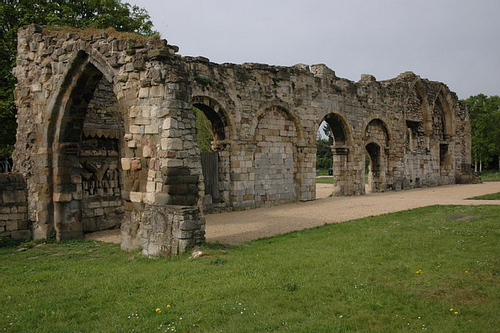
Aethelred was succeeded by Aethelflaed, who styled herself 'Lady of the Mercians.' Her experience governing alongside her husband and her ties to Mercia and Wessex made her well-suited to the role. She soon proved to be an equal, if not superior, leader to Aethelred, and in alliance with Edward, she led the reconquest of much of eastern Mercia from Viking settlers. After her death in 918, she was buried alongside her husband at St Oswald's Priory. Their daughter, Aelfwynn, briefly held power in Mercia but was deposed and replaced by Edward, who in turn was succeeded by his eldest son, Aethelstan, in 924. Having been raised in Mercia, Aethelstan was an adopted Mercian prince who enjoyed strong support in the region, and within three years, his northern conquests made him the first king of all of England.
Legacy
Aethelred ruled Mercia for about 30 years. From a purely Mercian standpoint, one might argue that he failed to uphold his kingdom's independence. Yet, he inherited a much-weakened Mercian, surrounded by rivals and needing some form of alliance with Wessex – the last remaining strong English polity – to survive. Despite this, Aethelred and Aethelflaed largely managed Mercian affairs with little interference from Alfred and Edward aside from their military obligations to Wessex, and the Mercia Aethelred left to his wife in 911 was politically stable, militarily strong, and had been united behind a leader who enjoyed a significant degree of autonomy. It was not until the failed reign of Aelfwynn that this Mercian dynasty was suppressed and Mercia fully united with Wessex under a single ruler.
It is difficult to gauge whether Aethelred subscribed to the vision of English unity that Alfred purported to engineer amongst his subjects or if he viewed himself purely as a Mercian leader, behaving in the best interests of Mercia. Yet, his oath of loyalty to Alfred, his marriage to Aethelflaed, and his fostering of Aethelstan very much tied him to the Alfredian vision of England. Though much is made of Aethelstan's apparent closeness with his aunt, Aethelflaed – which is the subject of a statue at Tamworth Castle (above) – there are hints that he was also close with Aethelred. For example, in 925, when Aethelstan granted certain privileges to St Oswald's Priory, he stated this was in fulfilment of a 'pact of paternal piety' he had made with Aethelred during his youth. Aethelred was one of several role models and examples of successful leadership – along with Alfred, Aethelflaed, and Edward – that Aethelstan had been exposed to as a boy, and no doubt shaped this future ruler of all England into the successful king he became.

